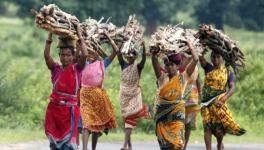When Green Talk Does Not Match Policy Decisions
Representational use only.
‘When we began our services in the late 1980s, hobnobbing with businessmen and entrepreneurs was considered taboo. If any bureaucrat would do it, they would be looked down upon. And in 2021, the chief minister of a state, with seven of his top bureaucrats, flies 1,000 km from Ranchi to Delhi to solicit and woo the same set of investors.’ So said Jharkhand Chief Secretary Sukhdev Singh on 28 August at the Taj Hotel in Delhi, during an investors meet where he described the new Jharkhand Industrial Investment Promotion Policy (JIIPP).
Singh referred to William Lee, the 16th-century British inventor whose patent application for a stocking manufacturing unit got rejected because it would put knitters out of work. A lot has changed since then. Today, “investors”, or those who control the levers of finance and capital, define the socio-economic sphere.
Accordingly, the Jharkhand government has started dreaming of developing the state into an “industrial miracle of the East”, in the words of Jitendra Kumar Singh, Director of Industries, Government of Jharkhand, at the same investors meet. The catch-phrases for what the state can do to “facilitate” the movement of capital are its plans to “synergise” industrial growth, “simplify” regulations and create an “industry-friendly” landscape.
The state government has promised investors lucrative incentives such as 100% reimbursement of State GST for nine years, an interest subsidy of up to Rs.3 crore, and a 5% “additional grant” for entrepreneurs from a Scheduled Caste or Scheduled Tribe, women and differently-abled entrepreneurs.
The rhetoric always is that incentives strengthen economic activity and boost employment. However, by 2021, India has seen enough miracle industrial cures that amount to little. In fact, the adverse impact of global warming should serve as a forewarning that industrialisation with minimal regulation, especially in primary sectors such as mining, can cause more harm than good. The sixth International Panel on Climate change (IPCC) assessment report published on 9 August warns of a sizeable rise in the average global temperature over recent decades says the window to avert its outcomes is shrinking. Still, the Jharkhand government has actively campaigned against the corporate takeover of natural resources, most evident in their famous slogan, “Ab khanan nahi paryatan hoga—Now, there will be tourism, not mining”. However, at its investors meet, environmental concerns and green investment were not referred to even once.
With state Chief Minister Hemant Soren in attendance, the meet ended with claims that Memorandums of Understanding (MoUs) and Intent of Investment worth Rs.10,000 crore were signed. Soren himself announced this figure at the meet. The top investors will be Tata Steel, an old player in Jharkhand. Dalmia Cements has also signed an MoU to set up a grinding unit at Bokaro, a solar plant and a solid waste management plant. Adhunik Power has signed an MoU to establish a plant near Jamshedpur, and SAIL has plans to expand its Gua iron ore mines. Prem Rubber Works has expressed interest in a leather park at Dhanbad and so on. Soren said the losses inflicted by the Covid-19 pandemic would soon be compensated by such investment inflow, leading to “20,000” direct and roughly 1 lakh indirect jobs.
Ironically, last June, Soren had approached the Supreme Court against the Union Coal Ministry and Prime Ministers Office, which had approved commercial mining and coal block auctions in the state. He had said on Twitter that the social and environmental impact of these activities need study. He also noted that both are “likely to be adversely affected” by mining.
Yet, now, the state seems to have taken a U-Turn, and there is no more talk about social or environmental assessment. Recall that the ruling Jharkhand Mukti Morcha (JMM) government had mocked the BJP’s “Flying Elephant” in 2017. The elephant was the BJP’s mascot for a Global Investors Summit its government had organised in Ranchi, with similar goals.
Salkhan Murmu, president, Adivasi Sengel Abhiyan, questioned the intent of the present government after the investor’s meet in Delhi. He said that the current government is no different from the previous one. He also said the tribals of the state are discontented with the pattern of industrialisation. Adivasis are a large labour force, and their lands are used to build dams, set up industries and carry out mining operations. Yet, basic amenities fail to reach them. Almost 49% of the Adivasis in Jharkhand live below the poverty line.
At current prices, the state GDP (GSDP) of Jharkhand is Rs.3,61,381 crore (US$ 49.48 billion). According to the most recent economic survey (March 2021), the primary sector's contribution is 9%. Agriculture and forestry contribute 16.1%. The tourism sector hardly contributes to the economy, reflecting untapped potential and the skewed priorities of successive governments.
One of the most ambitious projects of the present government is to establish an Electronic Manufacturing Cluster (EMC) at Adityapur in Seraikela Kharsawan district, which is being projected as the first-ever in eastern India. Pooja Singhal, Secretary, Industries, Jharkhand, said the government wants to host electronic manufacturers in a sprawling 238-acre zone. Electronic vehicle manufacturing plants, lithium ion-based batteries and electronic waste management plants are among the specialised sectors that the government is inviting to the cluster. Agrofood and meat processing—“personal preferences of the chief minister according to Ms Singhal—and pharmaceuticals, auto components, and ethanol plants are also in the pipeline. Singhal said starch, sugar and cellulose-based industries are highly encouraged as part of the policy to promote biofuel and “green” fuels.
A 240-acre plot in the Adityapur Industrial Area is trying to lure automobile manufacturers and lithium-ion battery units, both water-intensive and producing heavy metal waste. The residents of Adityapur have been complaining of falling rainfall levels for a few years. A recent report by Dainik Bhaskar says the Seraikela- Kharsawan district, under which the Adityapur Industrial Belt comes, received 20% less rainfall in August. Large scale land clearance to develop industrial zones are much to blame. In particular, agro-processing units have been established on former forest lands, destroying natural buffers. It should concern all since the world is yet to recover from the Covid-19 pandemic.
According to a recent UNEP assessment, increasing demand for animal protein, unsustainable agricultural intensification and climate change are among the human factors affecting the emergence of zoonotic diseases. Indeed, in nutrition-starved India, there is a need to encourage more animal protein consumption. But do the upcoming agro-processing units cater to health needs, and who in government will track if they are?
After all, the food-processing plants are accompanied by a contradictory zeal for ethanol production in Jharkhand. Jharkhand has seen several starvation deaths in the last few years, which successive governments have sought to paper over or deny. Senior journalist on rural issues, P. Sainath, has warned that rice crops must not get diverted to produce sanitisers and fuel where people suffer from malnutrition and die of starvation. Doing so is a travesty in the name of environmentalism, for the benefits of biofuel are unproven.
Similar objections were raised when the Union government auctioned coal blocks in Jharkhand. Mining does not just hurt the environment but barely provides a subsistence living to most workers and involves onerous conditions. It is not by accident that the mining belts are the least prosperous anywhere in India. Bharat Bhushan Choudhary, convener Jharkhand Janadhikar Mahasabha, a network of activists, has said the village councils must manage forest and forest produce. “We firmly believe in community ownership of natural resources,” as against the corporate-owned model proposed by the government.
However, it is not all doom and gloom, for progressive discourses are breaking out in Jharkhand and offering alternative routes to development. Their clash with capitalist interests defines the present politics of Jharkhand.
Chief Secretary Singh cited economist Jeffrey Sachs at the investor meeting to say that countries with inclement weather suffer from output problems. In contrast, the climate of Jharkhand is “perfect” for investments to succeed, he said. He said there is close to no labour unrest in the state and no organised extortion gangs. According to him, Naxalism is on the verge of collapse in a matter of months.
Ironically, Jharkhand’s Jharia mining town is the most polluted city in India, according to a Greenpeace India report from last year. Dhanbad, another rich coal reserve in Jharkhand, is the second most polluted city. An Egyptian Journal of Remote Sensing and Space Science study says that the average maximum temperature has significantly increased for over 30 years. The heating up is particularly evident in the north-western districts, where the temperature has risen from 1 to 1.5 degrees C. The study’s analysis of the Consecutive Dry Days (CDD) index has found that Palamu and Garhwa are the most vulnerable regions to drought and the most affected regions due to climate variability in Jharkhand. The journal has said that Jharkhand must focus on water resource conservation and manage the rapid urbanisation and deforestation-led changes in land use and forest cover. These, it says, would limit climatic fluctuations to an extent. Dry monsoon and high temperatures imply a greater risk of drought and consequent fall in crop yields, socio-economic instability, and more malnourishment. “The pressure on water resources needs to be regulated, as the society remains vulnerable when prolonged dry periods follow one another,” it notes.
While mining and industrialisation put pressure on natural resources and aid their transfer from the weaker to the privileged, Jharkhand is a tapestry of ecological synergy with rivers, lush forests, and diverse tribal groups. The state boasts 29.61% forest cover, 18 elephant corridors, and biodiversity hotspots like Betla National Park.
The JMM government has repeatedly said it will explore industries related to tourism and biodiversity, which are available in plenty in the state. These, Soren has said, can improve farmer incomes, help focus on linking livelihood with traditional forest dwellers, and uplift everybody sustainably. Even though a Tourism Policy (released in 2020) exists, no roadmap or action plan is publicly available. Promises, then, are mere rhetoric, and industrial investment will continue to ravage the state.
The author is an independent journalist based in Jharkhand. The views are personal.
Get the latest reports & analysis with people's perspective on Protests, movements & deep analytical videos, discussions of the current affairs in your Telegram app. Subscribe to NewsClick's Telegram channel & get Real-Time updates on stories, as they get published on our website.
























